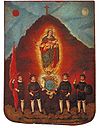Zacatecas City
| Zacatecas | ||
|---|---|---|
| City & Municipality | ||

View of Zacatecas
|
||
|
||
| Nickname(s): Ciudad de cantera, corazón de plata Civilizadora del Norte |
||
| Location in Mexico | ||
| Coordinates: 22°46′18″N 102°34′31″W / 22.77167°N 102.57528°W | ||
| Country | Mexico | |
| State | Zacatecas | |
| Founded | 1548 | |
| Municipal Status | 1825 | |
| Government | ||
| • Municipal President | Arnoldo Rodriguez Reyes | |
| Area | ||
| • Municipality | 356.14 km2 (137.51 sq mi) | |
| Elevation (of seat) | 2,440 m (8,010 ft) | |
| Population (2005) Municipality | ||
| • Municipality | 138,152 | |
| • Seat | 122,889 | |
| Time zone | CST (UTC−6) | |
| • Summer (DST) | CDT (UTC−5) | |
| Postal code (of seat) | 98000 | |
| Area code(s) | 492 | |
| Website | (Spanish) /Official site | |
| Official name | Historic Centre of Zacatecas | |
| Type | Cultural | |
| Criteria | II, IV | |
| Designated | 1993 (17th session) | |
| Reference no. | 676 | |
| State Party | Mexico | |
| Region | Latin America and the Caribbean | |
Zacatecas (Spanish pronunciation: [sakaˈtekas]) is a city and municipality in Mexico, and the capital and largest city of the state of Zacatecas. Located in north-central Mexico, the city had its start as a Spanish mining camp in the mid-16th century. Native Americans had already known about the area's rich deposits of silver and other minerals. Due to the wealth that the mines provided, Zacatecas quickly became one of the most important cities in New Spain, with much of its silver enriching the Spanish crown. The area saw battles during the turbulent 19th century, but the next major event was the Battle of Zacatecas during the Mexican Revolution when Francisco Villa captured the town, an event still celebrated every anniversary. Today, the colonial part of the city is a World Heritage Site, due to the Baroque and other structures built during its mining days. Mining still remains an important industry. The name Zacatecas is derived from the Zacateco people and has its roots in Nahuatl. The name means "people of the grasslands."
The first people to populate the area arrived approximately 10,000 years ago, when the climate was wetter and warmer, with different vegetation and wildlife. Eventually, the area became dominated by Chichimeca tribes such as the Caxcans, Guachichils, Guamares, Huichols, Zacatecos and others, with the Zacatecos being the most numerous in the area the city is today. These peoples were mining silver and other metals in these hills long before the Europeans arrived, making the area important in pre-Columbian times.
...
Wikipedia


